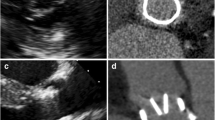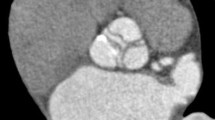Abstract
The purpose was to compare the findings of multi-detector computed tomography (MDCT) in prosthetic valve disorders using the operative findings as a gold standard. In a 3-year period, we prospectively enrolled 25 patients with 31 prosthetic heart valves. MDCT and transthoracic echocardiography (TTE) were done to evaluate pannus formation, prosthetic valve dysfunction, suture loosening (paravalvular leak) and pseudoaneurysm formation. Patients indicated for surgery received an operation within 1 week. The MDCT findings were compared with the operative findings. One patient with a Björk-Shiley valve could not be evaluated by MDCT due to a severe beam-hardening artifact; thus, the exclusion rate for MDCT was 3.2% (1/31). Prosthetic valve disorders were suspected in 12 patients by either MDCT or TTE. Six patients received an operation that included three redo aortic valve replacements, two redo mitral replacements and one Amplatzer ductal occluder occlusion of a mitral paravalvular leak. The concordance of MDCT for diagnosing and localizing prosthetic valve disorders and the surgical findings was 100%. Except for images impaired by severe beam-hardening artifacts, MDCT provides excellent delineation of prosthetic valve disorders.






Similar content being viewed by others
References
Lindblom D, Lindblom U, Qvist J, Lundström H (1990) Long-term relative survival rates after heart valve replacement. J Am Coll Cardiol 15:566–573
Groves P (2001) Surgery of valve disease: late results and late complications. Heart 86:715–721
Seiler C (2004) Management and follow up of prosthetic heart valves. Heart 90:818–824
Gupta R, Jammula P, Huang MH, Atar S, Ahmad M (2006) An unusual complication after aortic valve replacement. J Clin Ultrasound 34:361–364
Aslam AK, Aslam AF, Vasavada BC, Khan IA (2007) Prosthetic heart valves: types and echocardiographic evaluation. Int J Cardiol 122:99–110
Muratori M, Montorsi P, Teruzzi G, Celeste F, Doria E, Alamanni F, Pepi M (2006) Feasibility and diagnostic accuracy of quantitative assessment of mechanical prostheses leaflet motion by transthoracic and transesophageal echocardiography in suspected prosthetic valve dysfunction. Am J Cardiol 97:94–100
Sakamoto Y, Hashimoto K, Okuyama H, Ishii S, Shingo T, Kagawa H (2006) Prevalence of pannus formation after aortic valve replacement: clinical aspects and surgical management. J Artif Organs 9:199–202
Tsai IC, Lee T, Chen MC, Fu YC, Jan SL, Wang CC, Chang Y (2007) Visualization of neonatal coronary arteries on multidetector row CT: ECG-gated versus non-ECG-gated technique. Pediatr Radiol 37:818–825
Lee T, Tsai IC, Fu YC, Jan SL, Wang CC, Chang Y, Chen MC (2006) Using multidetector-row CT in neonates with complex congenital heart disease to replace diagnostic cardiac catheterization for anatomical investigation: initial experiences in technical and clinical feasibility. Pediatr Radiol 36:1273–1282
Tsai IC, Chen MC, Jan SL, Wang CC, Fu YC, Lin PC, Lee T (2008) Neonatal cardiac multidetector row CT: why and how we do it. Pediatr Radiol 38:438–451
Lee T, Tsai IC, Fu YC, Jan SL, Wang CC, Chang Y, Chen MC (2007) MDCT evaluation after closure of atrial septal defect with an Amplatzer septal occluder. AJR Am J Roentgenol 188:W431–W439
Leborgne L, Renard C, Tribouilloy C (2006) Usefulness of ECG-gated multi-detector computed tomography for the diagnosis of mechanical prosthetic valve dysfunction. Eur Heart J 27:2537
Teshima H, Aoyagi S, Hayashida N, Shojima T, Takagi K, Arinaga K, Yoshikawa K (2005) Dysfunction of an ATS valve in the aortic position: the first reported case caused by pannus formation. J Artif Organs 8:270–273
Faletra FF, Alain M, Moccetti T (2007) Blockage of bileaflet mitral valve prosthesis imaged by computed tomography virtual endoscopy. Heart 93:324
Numata S, Okada H, Kitahara H, Kawazoe K (2007) Four-dimensional evaluation of implanted mechanical valve with 64-row multi-detector computed tomography. Eur J Cardiothorac Surg 31:934
Teshima H, Hayashida N, Enomoto N, Aoyagi S, Okuda K, Uchida M (2003) Detection of pannus by multidetector-row computed tomography. Ann Thorac Surg 75:1631–1633
Teshima H, Hayashida N, Fukunaga S, Tayama E, Kawara T, Aoyagi S, Uchida M (2004) Usefulness of a multidetector-row computed tomography scanner for detecting pannus formation. Ann Thorac Surg 77:523–526
Tsai IC, Lee T, Lee WL, Tsao CR, Tsai WL, Chen MC, Ting CT (2007) Use of 40-detector row computed tomography before catheter coronary angiography to select early conservative versus early invasive treatment for patients with low-risk acute coronary syndrome. J Comput Assist Tomogr 31:258–264
Tsai IC, Lee T, Chen MC, Tsai WL, Lin PC, Liao WC (2007) Homogeneous enhancement in pediatric thoracic CT aortography using a novel and reproducible method: contrast-covering time. AJR Am J Roentgenol 188:1131–1137
Cedars-Sinai Medical Center Cardiology staff (2008) Cedars-Sinai Medical Center Prosthetic Heart Valve Information. Available at: http://www.csmc.edu/pdf/Heart_Valves.pdf Accessed on March 23, 2008
Fu YC, Bass J, Amin Z, Radtke W, Cheatham JP, Hellenbrand WE, Balzer D, Cao QL, Hijazi ZM (2006) Transcatheter closure of perimembranous ventricular septal defects using the new Amplatzer membranous VSD occluder: results of the U.S. phase I trial. J Am Coll Cardiol 47:319–325
Shapira Y, Hirsch R, Kornowski R, Hasdai D, Assali A, Vaturi M, Sievert H, Hein R, Battler A, Sagie A (2007) Percutaneous closure of perivalvular leaks with Amplatzer occluders: feasibility, safety, and short term results. J Heart Valve Dis 16:305–313
McCollough C, Cody D, Edyvean S, et al for the Diagnostic Imaging Council CT Committee (2008) AAPM report no. 96 The Measurement, Reporting, and Management of Radiation Dose in CT. American Association of Physicists in Medicine. Jan 2008
Brendzel AM, Rambod E, Jorgensen SM, Reyes DA, Chmelik MS, Ritman EL (2002) Three-dimensional imaging of fractures in outlet struts of Björk-Shiley convexo-concave heart valves by microcomputed tomography in vitro. J Heart Valve Dis 11:114–120
Acknowledgements
This research was supported in part by Taichung Veterans General Hospital under grants TCVGH-975506C and TCVGH-975504A.
Author information
Authors and Affiliations
Corresponding author
Additional information
Correctness of multi-detector-row computed tomography for diagnosing mechanical prosthetic heart valve disorders using operative findings as the gold standard
Electronic supplementary material
Below is the link to the electronic supplementary material.
Animation 4a
Three-chamber view of TTE showing normal prosthetic bileaflet valve motion. See Fig. 4a for annotation. Compared with animation 4c, the loosening regions of the prosthetic aortic valve were all blocked by the acoustic shadowing caused by the prosthesis itself (MPG 355 kb)
Three-chamber view of MDCT clearly demonstrating the loosening region near the fibrous continuity between the mitral and aortic valves. During systole, the valve is displaced superiorly, exposing the loosening defect. See Fig. 4c for annotation (MPG 522 kb)
Animation 5a
Serial MDCT images of the left ventricular outflow tract. The pannus (red arrows) is identified as a small black area just below the suture ring extending into the housing. The pannus is formed extensively, involving all three zones (MPG 1762 kb)
Rights and permissions
About this article
Cite this article
Tsai, IC., Lin, YK., Chang, Y. et al. Correctness of multi-detector-row computed tomography for diagnosing mechanical prosthetic heart valve disorders using operative findings as a gold standard. Eur Radiol 19, 857–867 (2009). https://doi.org/10.1007/s00330-008-1232-2
Received:
Revised:
Accepted:
Published:
Issue Date:
DOI: https://doi.org/10.1007/s00330-008-1232-2




